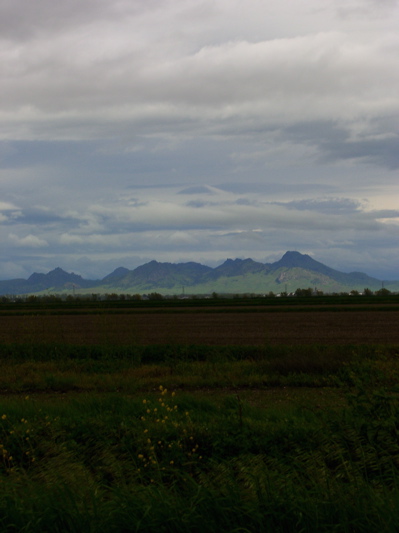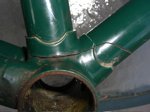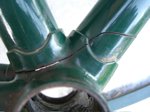
There’s a story that goes with the picture, really. But not for telling now — too tired after another hard ride, and a long drive to and from Central California on top of that. But the dog — he’s at our house. The picture is from a stop we made at a park down in Santa Clara County on the way north. The rest will wait. But I will say this animal’s arrival in our lives makes me want to re-read the Paul Auster novel “Timbuktu.”
Requiem for a Road Bike
Fifteen years ago, after having done a few long rides, including the Davis Double Century, I bought a bike I had developed a lust for (a lust, but only the chaste cycling kind). It was a Bridgestone RB-1, and was well-known for being a relatively light and sporty lugged steel road bike with a nice mix of components for a relatively modest price. I bought it at The Missing Link, a co-op shop in downtown Berkeley with a vague counterculture reputation, for about eight hundred dollars. I picked it up the week before the Grizzly Peak Century, a hilly 100-mile ride, and wondered during and after whether I had made a mistake. The bike worked fine, but it was geared sort of aggressively for a non-hill climber like myself. Back then, it wouldn’t have soon occurred to me to change the components to make it easier to ride, and I just got used to riding hills with what for me was an uncomfortably large smallest gear — 42×23 in cycling jargon (meaning my smaller front chainring had 42 teeth and my biggest rear cog had 23 teeth; in practical terms, that meant the rear wheel would turn about 1.85 times for every revolution of the cranks; that’s a big gear for a mere mortal struggling up a steep hill).
Since I bought the bike, I’ve had years where I rode a lot and many more when I did not. Sometimes the RB-1 would sit so long between rides that I had to dust it off before I took it out. But in 2003, when I decided to try to do Paris-Brest-Paris, the quadrennial 750-mile, 4-day ride in France, I decided I’d do it on the RB-1 rather than spring for a fancier and more expensive bike. By then, the bike had been out of production for nearly a decade, and it had sort of a cachet to it. I decided to strip off the original parts, have the bike repainted (by Ed Litton, a framebuilder up in Point Richmond), put new components on (including a triple crank with some low gears for when I started to fade) and ride it as new during the qualifying brevets leading up to PBP as well as during the main event. Ed’s paint job was simple but elegant — a dark green with a single ivory panel that displayed the Bridgestone decal. The bike’s spare, classic appearance and relative rarity — first that it was an RB-1, second that it was a lugged steel frame at a time they’re disappearing from the road in favor of titanium, carbon fiber and aluminum frames — drew some comment. Eventually, I, or maybe it was Kate, even gave it a name: Tir na nOg, Irish for “Land of the Young” (see the movie “Into the West” — the reference is explained there), which is where you get to on long, long bike rides.
PBP ’03 was a great experience, but then with one thing and another, I rode less in 2004 and 2005 before ramping up again this year in anticipation of PBP ’07. A couple months ago, though, I started to have some problems with Tir na nOg — the front derailleur seemed to not want to stay in adjustment. I fiddled with it myself, and so did more than one of the folks at The Missing Link. On April 1, I did a 300-kilometer brevet from Santa Cruz, through the mountains near town, and down to the Pinnacles and back. At the end of the ride, the shifting problem was bad. I put the bike aside afterward and have done some long rides since on my son Thom’s bike — a more modern steel Bianchi. I finally decided to take the RB-1 in to get looked at, again, yesterday. When I described what was going on, and how the crank seemed to be warped, Chuck, the mechanic, took a look at the frame near the bottom bracket.
“Here’s your problem,” he said. “You’ve got a cracked frame.” He pointed to a 1-inch fissure in the down tube — the diagonal one from the bottom bracket to the head tube. I couldn’t believe I hadn’t noticed it before, but then neither had anyone in the shop. Chuck said he’d strip the frame so I could bring it to a framebuilder for repair. I went back today, and he said, “I want to show you something.” Taking the components off the bike, he had discovered the crack ran a couple inches farther than we’d seen yesterday: Through the bottom-bracket lug where it receives the seat tube. The crack was so big I could see daylight through it. “I think it might be game over for this frame,” Chuck said — though he suggested I show it to a framebuilder in Oakland just to see whether there was any chance at fixing it. In any case, that’s the end of the long rides for this bike. As it happens, I have another freshly painted RB-1 frame I bought at the end of 2003 that’s just been sitting here in our house. I’ve been hesitant to spend the money to get it built up with all new components; now I’m going to have Chuck put it together with the gear from the old bike. If ti all works out, that will be my ride for next month’s Cascade 1,200 — a 750-miile, four-day ride in Washington state.
Technorati Tags: cycling
View of the Buttes
I’ve been away. Friday — getting ready for a bike ride. Saturday on a ride that lasted 24 hours, into Easter morning. Easter, sleeping; and eating. Today, tax day.
More about the ride later, but just one glimpse of what we took in on a route that went from the shore of San Francisco Bay up into the Central Valley, then across to the Sacramento River and tributaries to the very edge of the eastern foothills, then back to the lowlands in Davis. These are the Sutter Buttes, an isolated pocket of dead volcanic peaks that rise (the tallest is about 2,300 feet, I think) right in the middle of the valley. Since they’re surrounded by table-flat terrain for at least 30 miles in every direction, you can see them a long way off, they always look different depending on the light, and they always make an impression. Here, they were about 20 miles from where I was, just east of the town of Williams.

Technorati Tags: california, cycling
The Wind
Saturday was the day of the San Francisco Randonneurs 400-kilometer brevet. That’s 250 miles in American Distance Units. Far enough that unless you’re very strong and very fast, you face the reality that you’re going to need to sit on your bike all day and a good part of the night to finish. Without going into all the particulars of the ride — the stuff that always lasts in my memory is the landscape, whatever the landscape happens to be — the dominating factor on the ride was the wind. A storm blew through early Friday, and Saturday was dry. But as often happens after a storm passes, the wind along the coast and in the Central Valley blows hard from the north or northwest. Our route included a 60-mile leg that turned out to be more or less straight into a fairly fierce post-storm breeze. It’s hard to describe how implacable a force it turns into when you realize you’ll be facing it for four or five or six hours or more. The best thing that the wind did, though, was encourage riders to group up — riding together offers some protection if you can organize a paceline to share the work of leading the pack. That happened rather spontaneously on Saturday, and I spent most of the ride with four or five other riders. And of course, the best thing about a headwind is that it becomes a tailwind if both you and it persist long enough. At sunset and during twilight on the way back to down the Sacramento Valley, we just bucketed along. Here’s a little report on the day’s chief meteorological feature that I wrote up for my fellow riders:
Poking around some National Weather Service data, I can’t find any data from along our route. But reports from the west-central Sacramento Valley and the foothills just to the west show sustained winds in the high teens to mid 20s (mph) most of the afternoon with gusts in the low to mid 30s. The National Weather Service wind speeds represent a two-minute average ending at the time indicated; the gust speed is the highest speed recorded during the two minutes.
Highlights:
–The recording station at Corning (Olive Capital of the World, 57 miles north of Williams) recorded a 23 mph wind from the northwest gusting to 35 at 1:50 p.m.
–At the Sacramento National Wildlife Refuge, near Willows (Gateway to Elk Creek, 28 miles north of Williams), wind speeds were recorded at 21 or 22 mph, gusting from 30-32 mph, for every hour between 9:40 a.m. and 2:40 p.m.
–Further east in the Valley, winds were a little less extreme: Marysville (Where Yuba City Looks for Thrift-Store Bargains) had sustained winds up to 18 mph (1:50 p.m.) and gusts up to 28 (at 10:50 a.m. and 1:50 p.m.). Chico (They Have a Peet’s There Now) reported an 18 mph wind at 1:50 p.m. and gusts as high as 31 (2:50 p.m.)
–At Brooks (Gambling Mecca of All Yolo County), sustained wind speeds were lower, in the low to mid teens, but were gusting up to 26 mph.
–Thomes Creek, in the hills west of Orland (Home of the Famous Highway 32 Dog-leg Turn), had the same pattern, but with wind gusts up to 33 mph.
Technorati Tags: california election, cycling
Bypass

My friend and fellow cyclist Bruce Berg and I took a long driving trip to reconnoiter a route for a 24-hour ride we’re planning for mid-April. Our route takes us across the Sacramento Valley on back roads between the towns of Colusa and Yuba City. Here’s part of the route — Pass Road, about 10 miles west of the little town of Sutter. The suggestion of a mountain rising into the clouds on the left is one of the Sutter Buttes, a pocket mountain range that rises up from the table-flat valley. Needless to say, I hope, we took a look at the road here and decide that even though it didn’t look too deep for the 400 or 500 yards that the pavement was covered, we probably didn’t want to venture in.
Just to be clear: This isn’t the river proper, but the Sutter Bypass, one of a number of engineered channels that divert water from the main stream when the Sacramento is near flood stage. It’s a reminder of the natural state of the valley before settlers arrived and went to work improving it: In the wintertime, all the water running into it from the upland rivers would collect and turn it into a giant shallow sea — hundreds of miles long and as much as 120 miles wide.
An example: We noticed a historical marker yesterday for Johnson’s Ranch, renowned as one of the earliest American settlements in the valley and as the place to which the Donner Party survivors were first brought after their rescue. In looking up some details about that story, I found an account that talked about the flooding in the valley in the late winter and early spring of 1847:
“At Johnson’s Ranch there were only three or four families of poor emigrants. Nothing could be done toward relieving those at Donner Lake until help could arrive from Sutter’s Fort. A rainy winter had flooded Bear River, and rendered the Sacramento plains a vast quagmire. Yet one man volunteered to go to Sacramento with the tale of horror, and get men and provisions. This man was John Rhodes. Lashing two pine logs together with rawhides, and forming a raft, John Rhodes was ferried over Bear River. Taking his shoes in his hands, and rolling his pants up above his knees, he started on foot through water that frequently was from one to three feet deep. Some time during the night he reached the Fort.”
Technorati Tags: california election, cycling
Conquest of Mount Hamilton
Sent to my bike club email list (and by way of explaining Saturday — I was out leading a bike ride):
Fourteen of us started the ride southeast to Livermore and on to Mines Road from Berkeley this morning. We had a little drama going into the ride; it appeared doubtful that, after snow Thursday and Friday on Mount Hamilton, the road over the summit would be open. The fallback plan was a ride up to the junction where Mines Road turns into San Antonio Valley Road and Del Puerto Canyon Road descends east to the San Joaquin Valley; the group could eat at the always-interesting Junction Cafe, and judging by questions I got as we rode out to Livermore, the idea of pushing on toward Mount Hamilton, snow or no snow, was on more than one rider’s mind. But no sooner had we hit the road than a rumor disturbed our ersatz peloton: The Junction had shut down and we wouldn’t be able to get lunch there.
After several halts for clothing changes, delayed riders, and a broken spoke on Steve Downey’s bike that received expert first aid from Ernesto Montanero (Steve rode the final 90 miles on Ernesto’s temporary fix), most of the group hung together for the final 20 miles into Livermore, where we enjoyed the customary calorie-consumption binge. Asking around and finally getting the Junction’s phone number (by calling 411), we found out it was open but that the road was still closed past the cafe. At this point, our group started to shrink. Michael Tigges and Susan Jacobsen (riding a brand-new Seven), turned back as planned after tucking into an early lunch at Tequila’s Taqueria, the Grizzly Peak Cyclists’ unofficial Eastern Alameda County Burrito Sponsor. The remaining dozen of us rode out South Livermore Avenue and Tesla to Mines Road in a sociable and easy-paced double paceline; it lasted only 6 or 7 miles, but it was one of those things you wished could go on forever. But soon we came to the turn that would take us up the east wall of the canyon that rises above Arroyo Mocho. At this point, another rump contingent departed as Mark Abrahams and Estella Garcia, on Mark’s tandem, and Rich Fisher turned around to head back to Berkeley.
That left nine of us continuing up the hill. Patrick Gordis, who had shown turns of speed all morning, was the first to disappear up the road; he reportedly made it to The Junction a full 20 minutes ahead of a following trio of strong riders: Ernesto, Mark Homrighausen, and Joa Weber (who today recorded his 3,000th kilometer ridden since January 1; you do the math). Steve, Bruce Berg, Bruce Marchant, Scott Steketee (still on a recumbent as he heals from flesh-eating Hawaiian saddle sores), and I paid gravity its proper due (some of us more than others). On the last summit north of the junction, with badly fried cheeseburgers so close you could almost taste them, Bruce turned back and collected Scott for their early return trip to Pleasanton. Steve, Bruce M. and I descended the last hill to the junction.
The cafe was as usual: Monster trucks on the tube and lots of biker leather slouching at the tables. But everybody ate and drank and tried to take advantage of the wood-burning stove because the sight of snow on the ridges in the distance suddenly made it seem pretty chilly. The ride back was fast and fun, and the final seven of us arrived at Pleasanton BART together just about 5 p.m. I highly recommend the Chevy’s about five doors down from the station.
Total mileage: 117.3
Mileage Scoreboard
For Saturday, May 21:
Drove: 125 miles
Cycled: 202 miles
Davis Double Century.
Tired.
More later.


